Birch trees care and growing guide: expert tips for these elegant wonders
Find out how to grow birch trees with distinctive bark and dazzling foliage for year-long interest

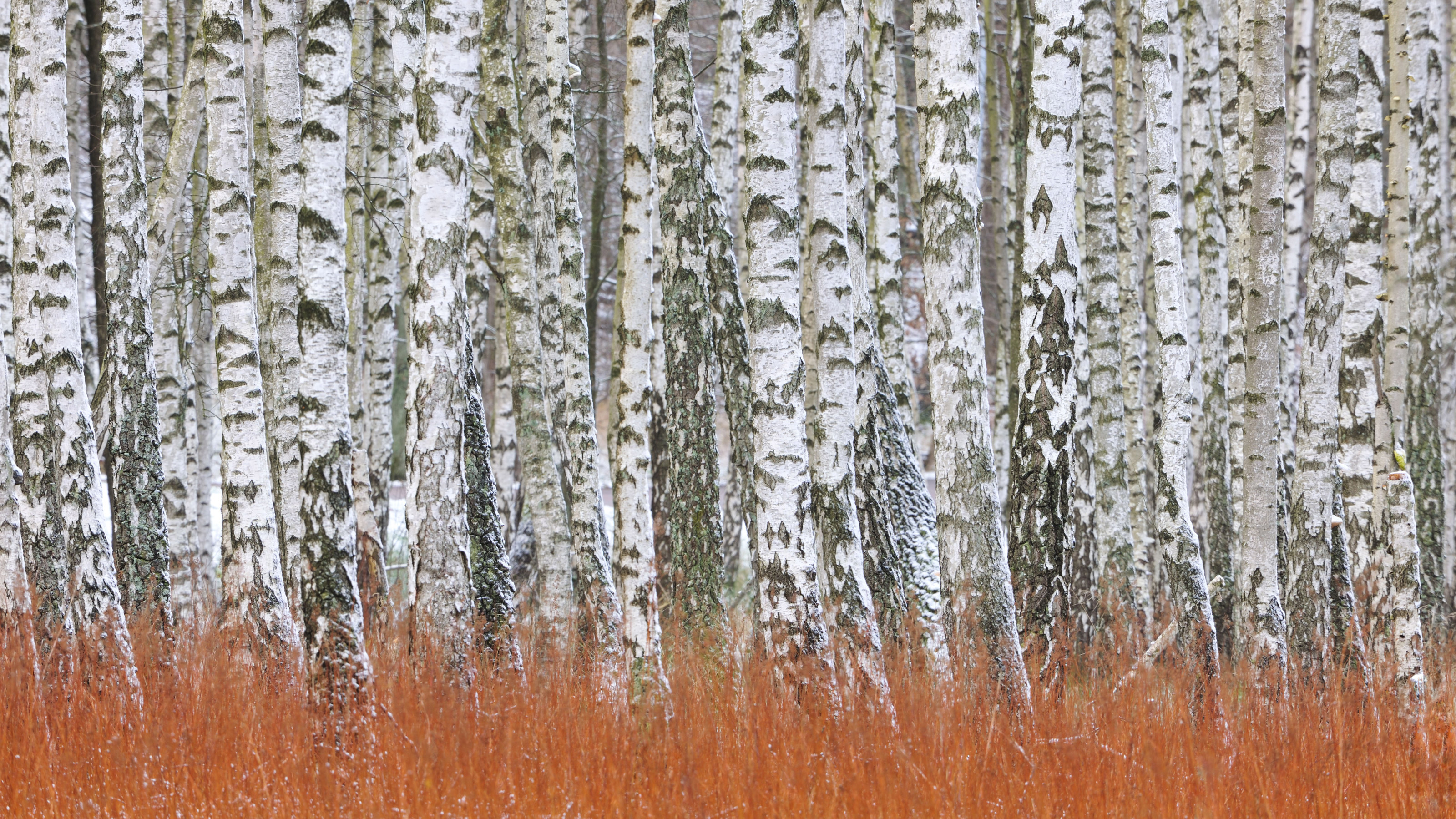
Birch trees bring a touch of enduring texture and brilliance to even the most modest-sized gardens. Birches are small- to medium-sized deciduous trees which are favored for their elegant shape, their often silvery white bark, their early-season catkins, and their rich fall foliage.
Birch trees grow and develop a presence more quickly than most garden trees, although they are not as long-lived as maples, oaks and larger forest trees. Given their ability to establish quickly, they are ideal trees for small gardens.
The distinctive bark of birch (Betula) trees is often white, though sometimes tinged with pink or pale coppery tones, and it makes an attractive feature, especially in winter. On certain birch varieties, the bark can be peeled back to reveal bright, freshly colored bark within. Multi-stemmed plants, or three plants set very close together, create the most impressive winter impact. Birches also create impact at other times of year, with yellow catkins hanging from bare branches early in the season, followed by small diamond-shaped leaves which often turn a bright buttery yellow in the fall.
The brilliance of their fall foliage displays seems to vary less from year to year than with many trees grown for autumnal splendor. While the best evergreen trees you can think of may offer reliable, long-lasting shapes and textures, birch trees offer a changing tapestry of rich and varied tones. Because of their ability to adapt across the seasons, birches are an ideal choice for year-round interest. Find out how to grow your own elegant birches and add a flourish of unique beauty to your plot…
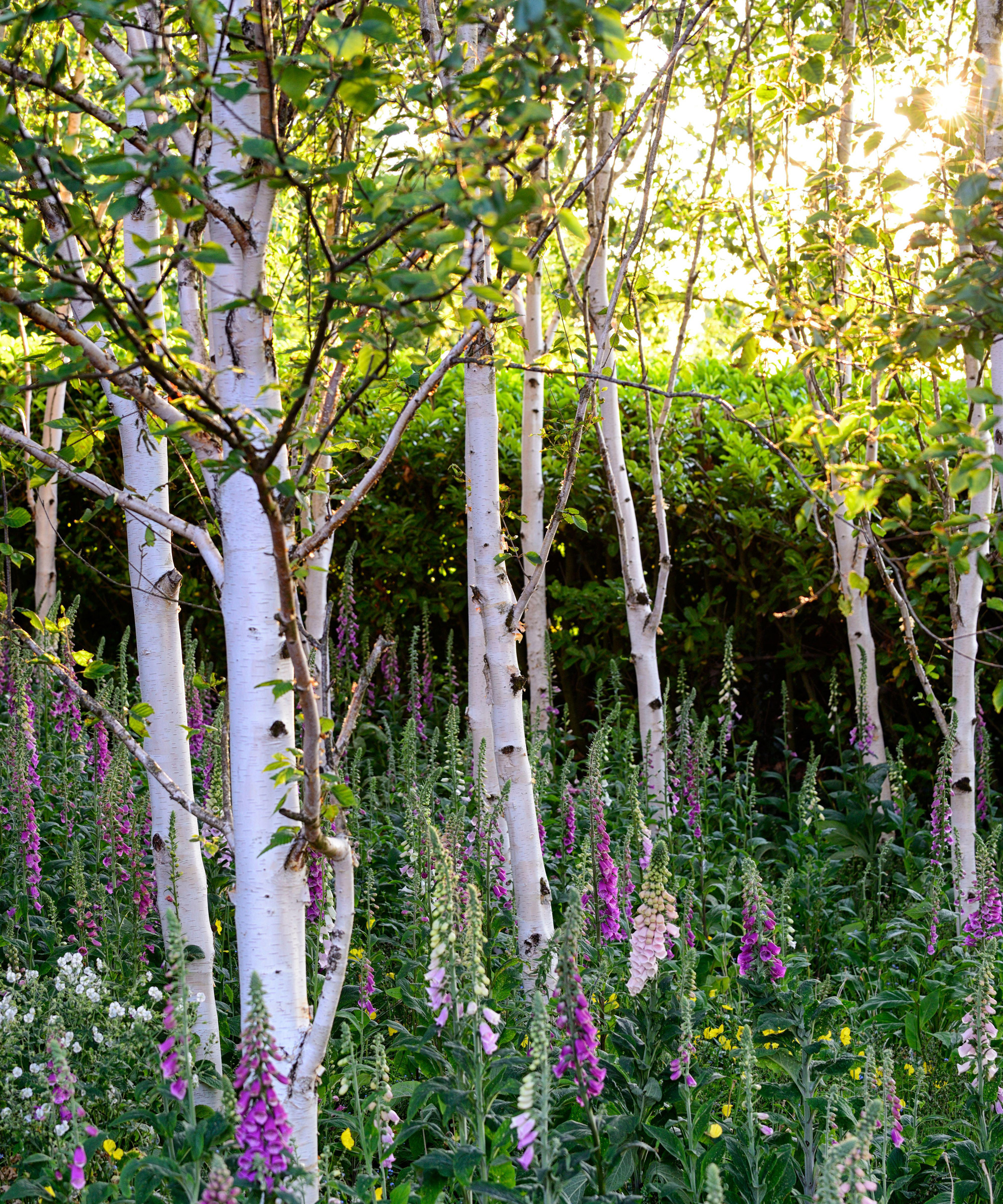
Birch trees: key facts
- Plant type: Hardy deciduous tree
- Mature size: 15-80ft (5-25m)
- Soil type: Moist, but well-drained
- Soil PH: Slightly acid, neutral, slightly alkaline
- Time of year to plant: Fall, winter, spring
- Flowering time of year: Early spring
- Flower color: Yellow
- Hardiness zones: USDA Z3 (RHS H7)
- Scientific name: Betula
- Common name: Birch
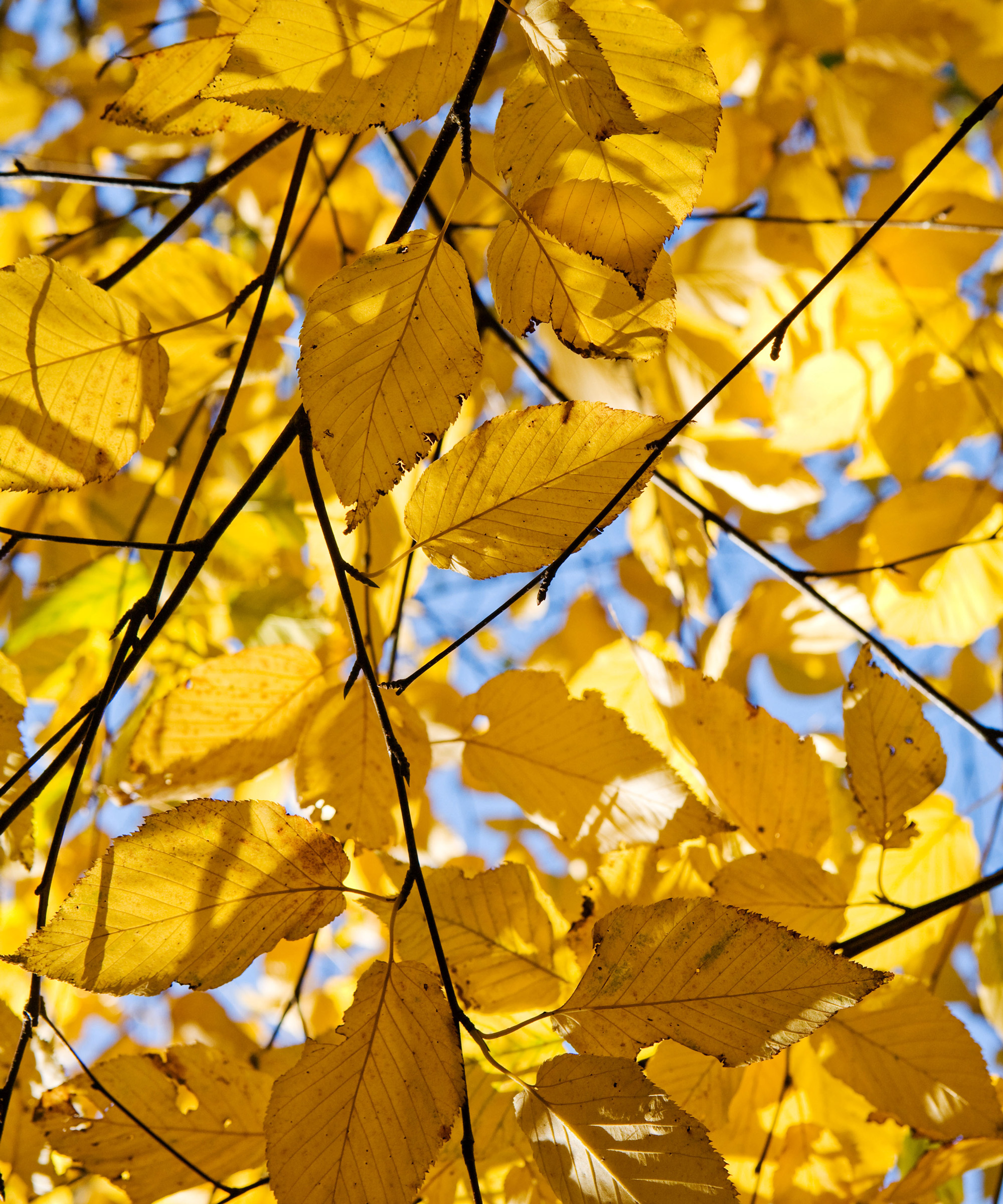
Which birch trees are best?
When you are selecting the best birch trees for your needs, bear in mind that they are mainly undemanding. Birches are generally resilient to the cold (down to USDA Z3), so winter hardiness is not likely to be an issue. These trees are adaptable and tolerant of a range of conditions. They will grow well in most soils, although river birch (Betula nigra) and silver birch (B. pendula) are especially suited to wet conditions. Try to avoid growing in shallow, chalky soils. Birches are not so keen on high humidity and hot summers, either.
There is plenty of variety in the birches that can be grown for color and texture. When choosing a tree for your garden, give some thought to whether you would prefer to grow native or non-native birch trees. Many gardeners prefer to plant native species, but many of those with the most attractive barks, for example, are forms of the Himalayan birch (Betula utilis) and are not native.
Birches are some of the best trees for small gardens, thanks to the fact that they are quick to establish. However, although they are generally small-medium in size as they mature, height may still be an issue, and reducing the size of a mature tree is a skilled job. Birches of relatively modest growth include Arctic birch (B. nana), Young’s weeping birch (B. pendula ‘Youngii’) and purple-leaved Betula ‘Royal Frost’.
Give some thought to what you rate most important about birches, as this may have some bearing on the varieties you grow and where you can grow them. Birches are grown for the following reasons:
- Growth habit: Birches vary from upright, to rounded, to weeping in growth. They cast light shade, but have shallow roots.
- Trunks: The bark of many birch trees makes a striking winter feature. The white bark of the Himalayan birch (B. utilis) shines in the winter sun. Some gardeners even wash it to accentuate its brightness.
- Catkins: In late winter-early spring, bare branches fill with pendulous catkins to 5in (13cm) long. Variety ‘Fascination’ has the longest catkins of all, but birch pollen can cause an allergic reaction in some people.
- Fall foliage: The foliage of many birch trees turns bright yellow in the fall. The foliage of the native cherry birch (B. lenta) is amongst the finest for its autumn coloring.
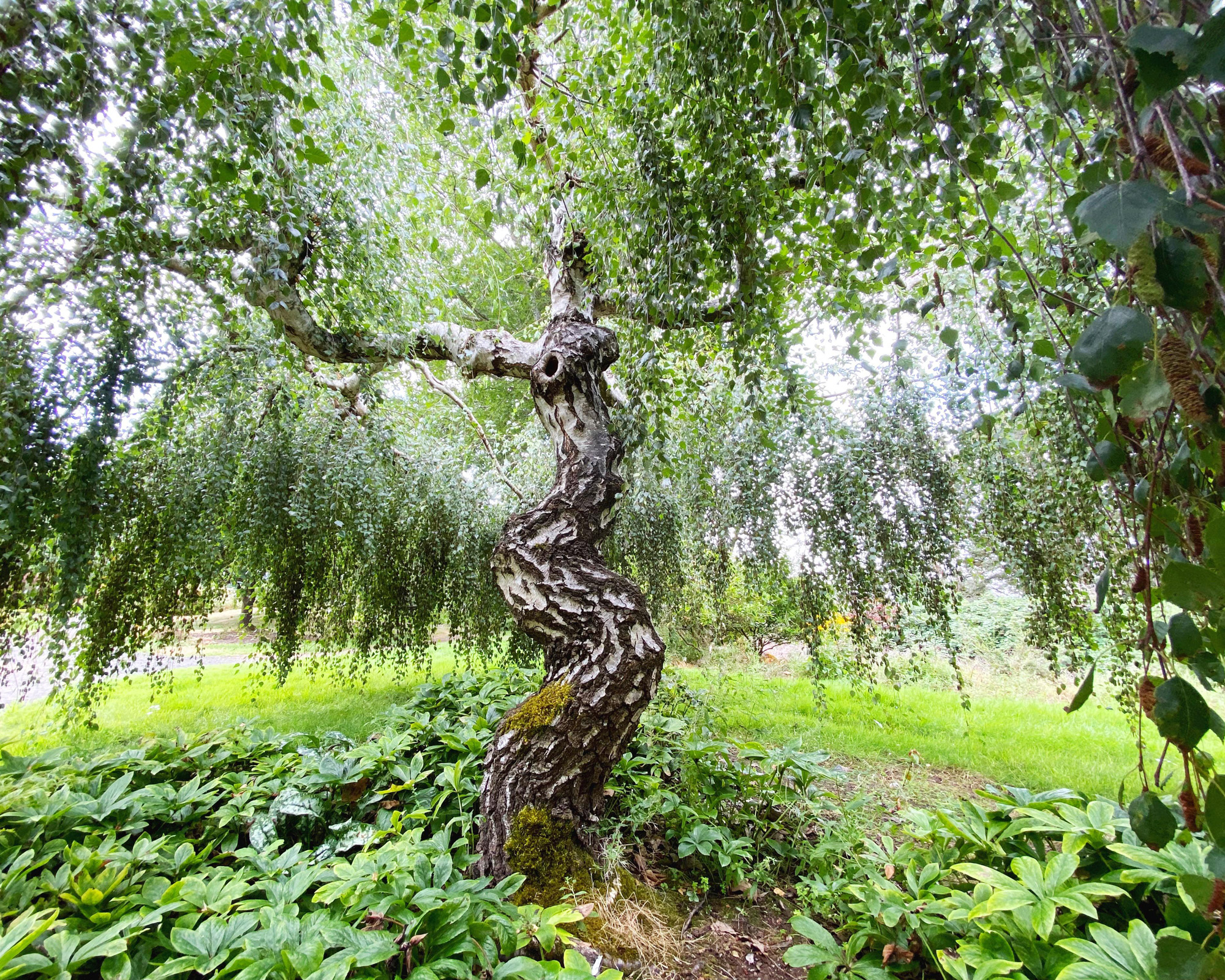
How to plant birch trees
Birch trees are some of the best low maintenance trees you can grow and they do not need any special planting treatment. They can be planted in late fall, winter or early spring, as long as the ground is not waterlogged, parched or frozen. They can even be planted later in spring if they are carefully looked after. Just avoid planting in high summer.
These are quite easygoing in terms of position. They are some of the best trees for front yards and amongst the best backyard trees you can plant. In terms of ground preparation, minimal attention is required. Birches are more shallow-rooting than many trees, so it is not necessary to prepare a deep planting hole. As a general rule, aim for a hole as deep as the rootball, and two or three times as wide. Amend the soil with weed-free organic matter and then plant firmly.
Although birches do not develop a dense head that catches the wind, staking is important. Driving a 4ft (1.2m) stake in at a 450 angle, secured to the trunk 2ft (60cm) above the ground, works well. Irrigate well after planting, and add a bio-stimulant or seaweed booster to the water, then finish with a good mulching to get things off to the best start.
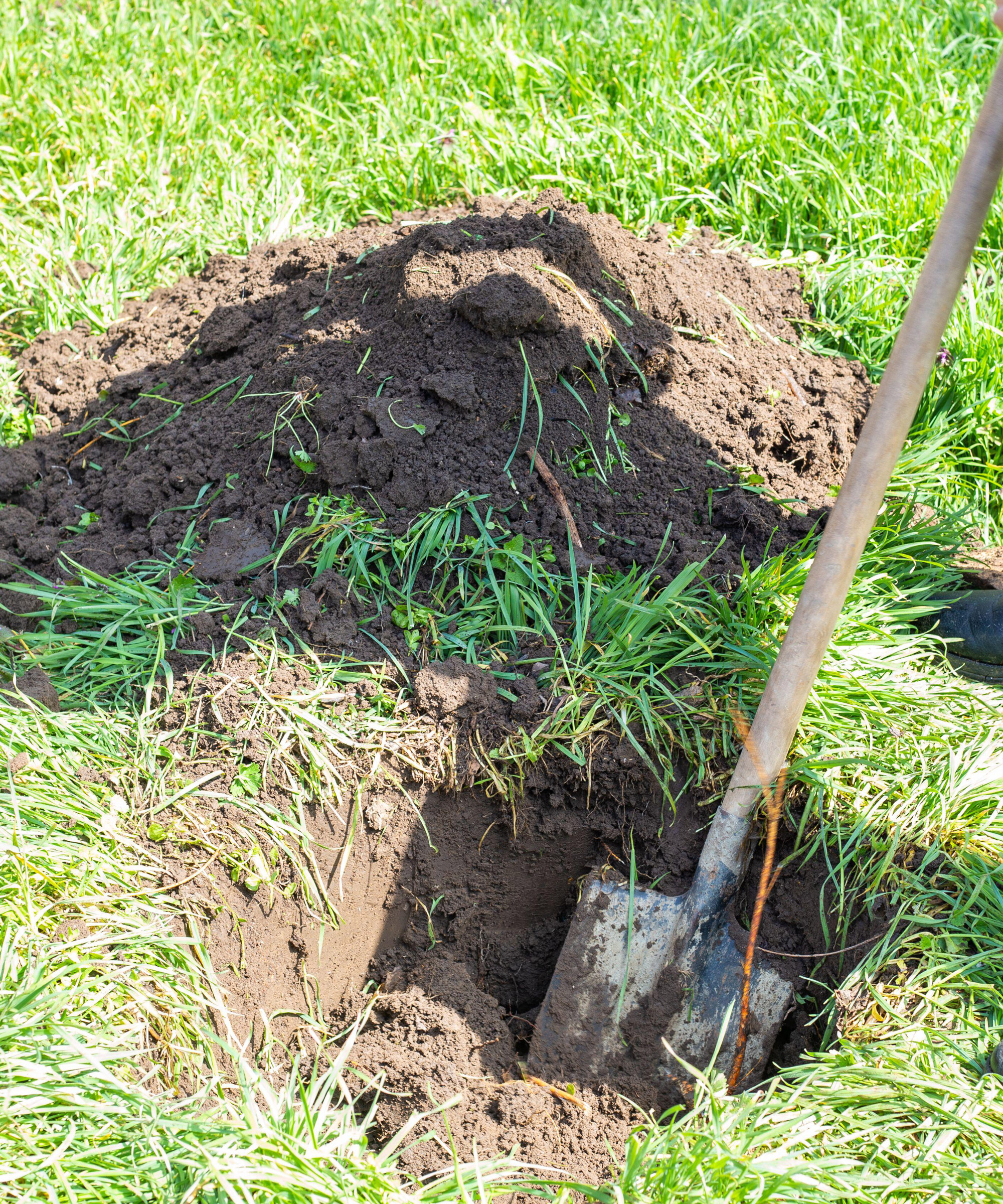
Growing birch trees in containers
If you were wondering if you could grow birch trees in pots, then the answer is a resounding ‘yes’. Specimen birch trees can be grown in large containers. They make impactful statement pieces as part of inventive patio gardening ideas and also work well on the deck. However, it is important to remember that although they can take a little drought, birches will only grow well in containers if their roots are kept moist and they are fed regularly. Setting up a drip system that is activated at the touch of a switch, or controlled by a timer, is the most effective way to keep your birch consistently well watered.
You should also think carefully before siting your containerized birch tree. As with many great container gardening ideas, you need to plan ahead as mobility can quickly become an issue. You will likely bring in the container, potting soil and tree separately, but when planted up and watered, the combined weight will make it virtually impossible to move later. Even if this is not true straight away, it will become an issue once the tree matures and has to be transplanted into a larger container. Finally, try to position the potted birch so that the container itself, at least, is in the shade, since birches dislike hot roots.
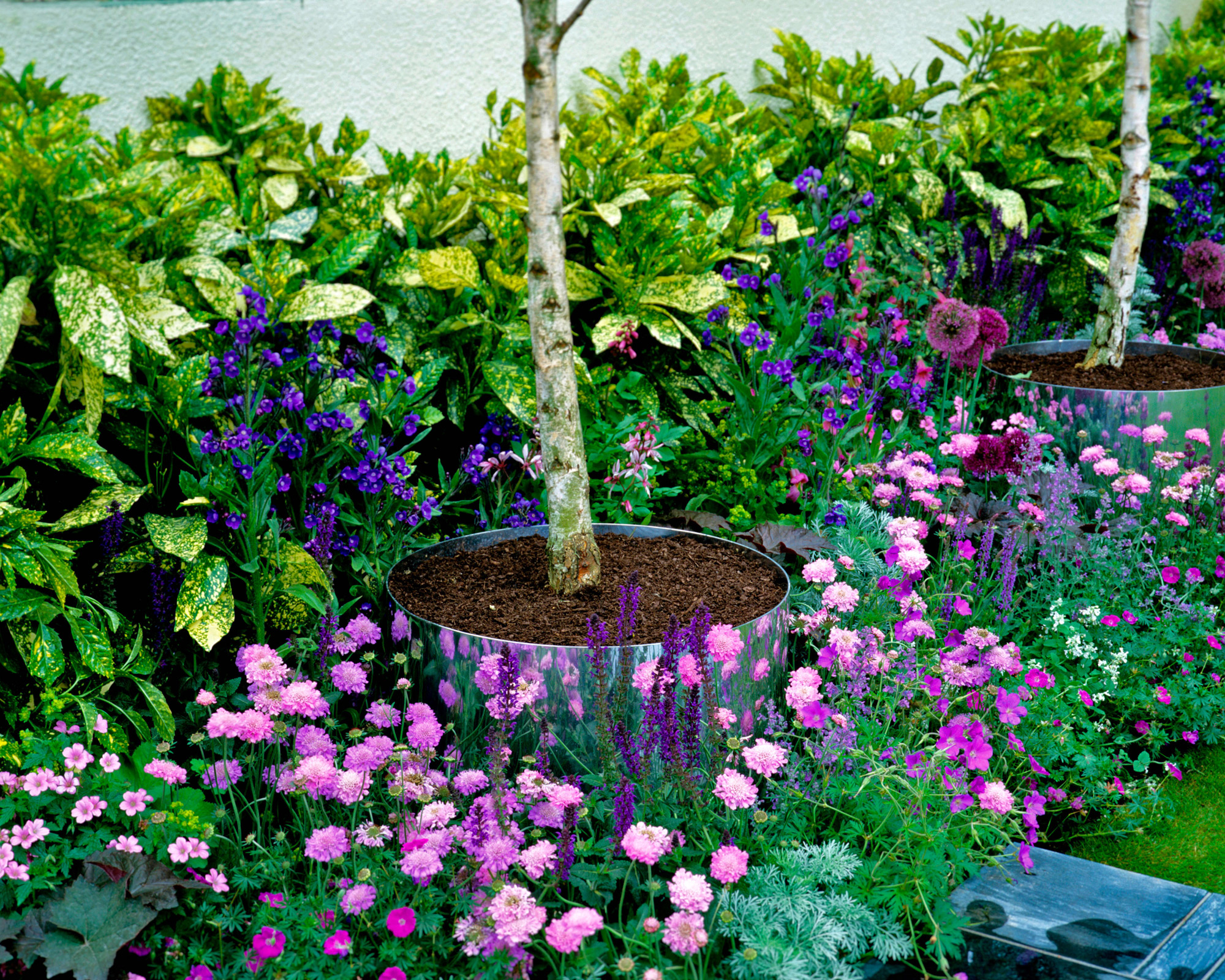
How to care for birch trees
Fortunately, birches do not demand a great deal of attention. Because they are some of the best fast-growing trees you can try, you will find that growth tends to be rapid in the early years. For this reason, you need to irrigate in dry spells during the first year or two after planting to prevent growth being limited by drought. You should renew the mulch annually to help retain moisture, prevent weed growth and keep the roots cool. Checking tree ties and tree supports regularly is also important in a tree’s early years, so repair these promptly as needed.
For those who are minded to keep an eye on pruning shrubs in their gardens, the good news here is that birch pruning is rarely necessary. The only time you need to prune birches is if a tree is damaged or grows too large for its space. Always prune in late summer or early fall, as spring pruning is usually followed by sap bleeding from the wound. As the tree develops, remove low side branches flush with the trunk year by year, leaving a bare trunk 5-6ft (1.5-1.8m) high that is clear of branches. This will help to show off the bark’s coloring most effectively.

How to propagate birch trees
Birch trees often produce a great many seeds that are carried away in the wind. Some of these seeds will germinate, sprout and develop into birch seedlings. This can happen in a variety of environments, even in perilous or parched conditions. In late winter, these seedlings can be carefully dug up and planted in a lightly shaded, out-of-the-way place. They can then be moved to their final positions when they are a few years old.
Birches can also be grown from cuttings taken in summer when the new growth is starting to harden. In much the same way that you would take cuttings from plants, you can make more birches using birch cuttings. Just follow these simple steps:
- Cut shoots approximately 4-6in (10-15cm) long from the tips of the new growth. Trim below a leaf joint and snip the leaves off the lower half.
- Dip the bases of the birch cuttings in rooting hormone and then insert them in pots of fresh potting soil.
- Stand the pot inside a plastic bag, leave the top open. Mist occasionally until rooting takes place. Then move into individual pots to grow on.

Problems with birch trees and how to solve them
Birch trees are troubled by few problems, the worst being the bronze birch borer. This is a small wood-boring beetle that tunnels under the bark and blocks the tree’s moisture-moving channels. It can kill whole branches, usually the upper ones first. According to the entomologists at Purdue University, vigorously growing trees are less inclined to be damaged by borers than trees in poor condition. Birch trees are relatively short-lived so old age, adverse weather conditions or other insect-related stresses can all contribute to weakened trees, entomologists claim.
Other problems such as infestation by aphids, a long summer drought or competition between the shallow birch roots and lawn grass around the tree may also make trees vulnerable. For those looking to get rid of aphids, do not attempt to spray whole trees with insecticide; this is not only difficult, but a huge range of beneficial insects will also be killed. Instead, maintain healthy trees by regular watering or plant a resistant variety in the first place. Consider ‘Dakota Pinnacle’, the three varieties in the Renaissance Series, and ‘Whitespire’.

What are the most common birch trees?
Depending on your region, common types of birch will vary. Ability to adapt to different climates and soil types makes some kinds of birch more prevalent than others. Some birch trees are more commonly found in the wild, whereas others are more popular in gardens. You can turn this to your advantage if you are growing plants for particular garden color schemes or thematic plantings, particularly if you know that your birch of choice has a specific bark shade.
- Common birch trees in the US:
The most common native birch tree is paper birch (Betula papyrifera). It grows across all of Canada, and much of the northern United States as far south as Virginia and Colorado. The native river birch (B. nigra) prefers slightly warmer conditions and is native across the north and east from Wisconsin south to Florida. In gardens and yards, B. nigra ‘Heritage’, with its peeling creamy bark, is exceptionally popular and is widely grown. This bark works well with purple flowers and blue tones. - Common birch trees in the UK:
Three native birch trees grow wild in Britain, and the silver birch (B. pendula) and downy birch (B. pubescens) are widely seen. The silver birch grows over almost the whole country but with the bias to the south. The downy birch is stronger in Scotland. Silver birch tends to be found in dense stands, while downy birch is more often seen as individual trees or in mixed woodland. In gardens, varieties of the Himalayan birch (B. utulis) are the most common, especially white-barked ‘Doorenbos’, ‘Grayswood Ghost’ (shown), ‘Jacquemontii’ and ‘Silver Shadow’. This bright bark works well with yellow flowers and red floral plantings.
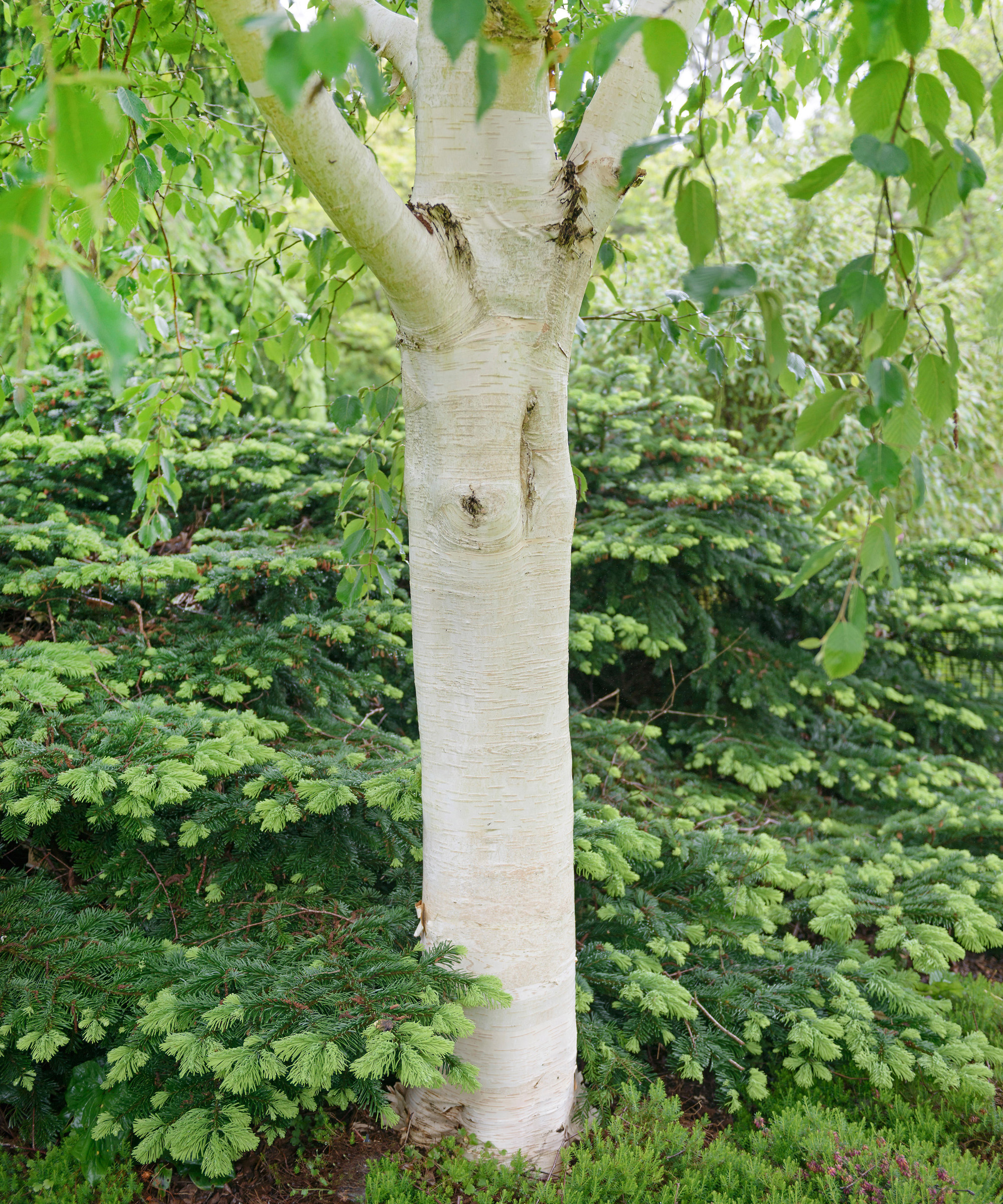
How quickly do birch trees grow?
Birch trees grow quickly, but are not long lived. When growing well, the silver birch (Betula pendula) can reach 25ft (8m) in 10 years and 60ft (18m) after 20 years, but some birch trees die in 60 years and most will be dead at 90 – compare this with the lifespan of hundreds of years for an oak or maple. Wind-blown birch seeds are often the first to spring up in cleared forests or on urban brownfield sites and quickly make stands of young trees. But decades later, they are overtaken by slower-growing but longer-lived oaks and other forest trees.
The speed at which they make an elegant tree, combined with the fact that they only cast a light shade, make them good trees for new gardens. However, their shallow roots suck moisture from the soil, limiting the plants that thrive beneath. Some of the best plants under trees include low-growing bulbs like cyclamen, snowdrops and lily-of-the-valley. Other well-positioned underplantings include hostas, hellebores and dicentra.

Are birch trees deer resistant?
Some birches are rated as ‘rarely damaged’, the highest category of deer resistance, as assessed by the New Jersey Agricultural Experiment Station (NJAES). They run a program in which they consult a wide range of landscape professionals, horticulturalists of all kinds, designers and researchers to identify the garden plants that deer prefer to eat – and those they do not. Other birches are less deer-resistant and are rated as ‘seldom severely damaged’. So for those interested in deer-resistant plants, shrubs and trees, there is some good news for birch growers.
In the ‘rarely damaged’ category are two North American native species: paper birch (Betula papyrifera) and river birch (B. nigra). Birches in the ‘seldom severely damaged’ category are the native yellow birch (B. alleghaniensis), and Himalayan birch (B. utilis). The European white birch (B. pendula) is also rated as ‘seldom severely damaged’ but should not normally be planted, as it is considered invasive.

Are birch trees invasive?
The European white birch (Betula pendula) has been planted to help reclaim industrial landfills and mine slags, as it is highly tolerant of polluted soil; it was thought to be an ideal plant for this use. A half-grown tree can produce almost 140,000 wind-blown seeds in a single season, and they not only sprout in difficult situations but have also proved invaluable in a wide range of other situations.
So the European white birch is now growing in the wild across the northern states and is considered invasive in the states of Kentucky, Maryland, Washington and Wisconsin, as well as in parts of Canada. In parts of Ontario, it has become the dominant tree. As regards general landscaping around trees, just bear in mind that planting European white birch in the US should be avoided. Instead, consider the native river birch (B. nigra) or Himalayan birch (B. utilis).
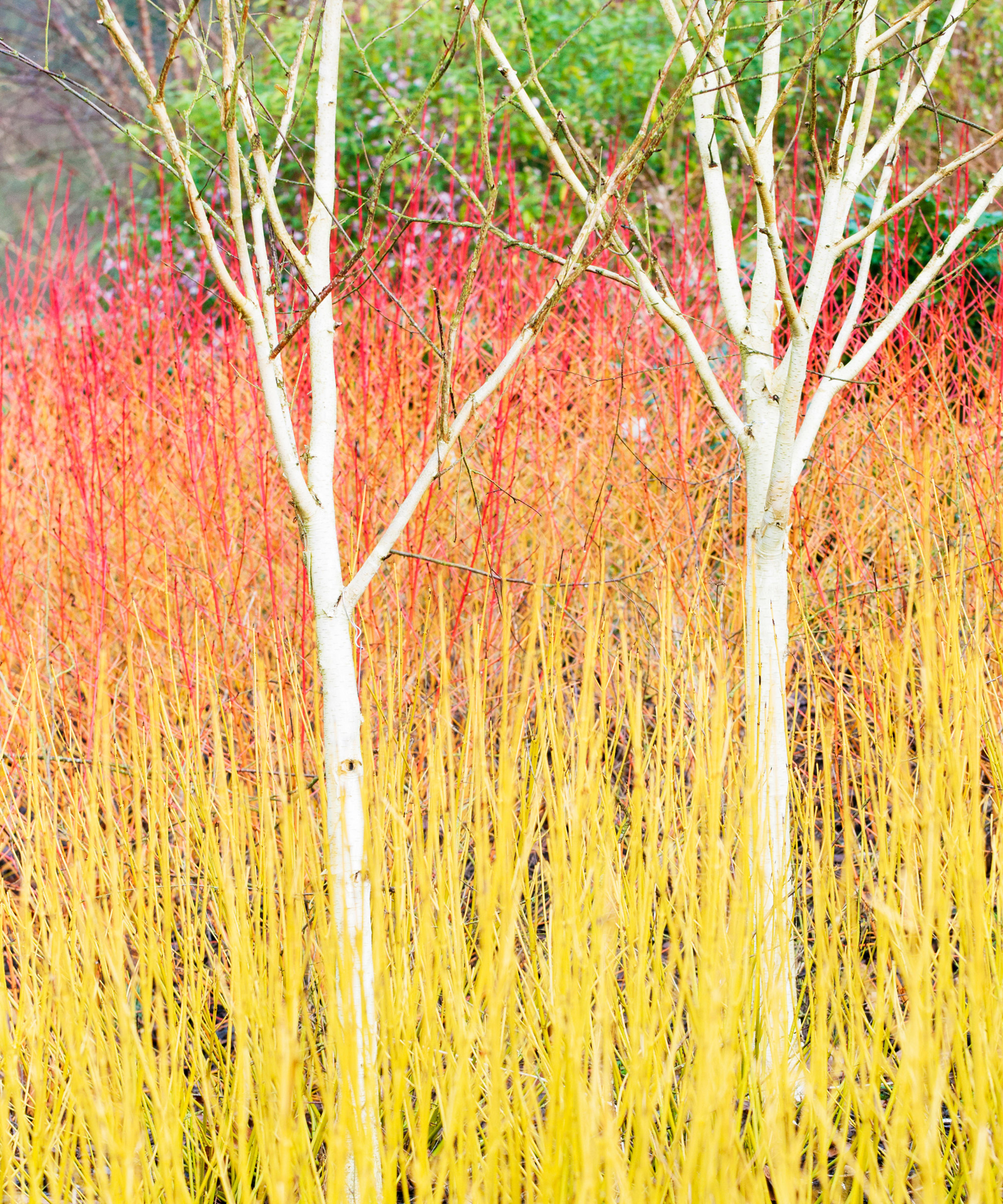
Where to buy birch trees
In fall and spring, birch trees are often seen in walk-in nurseries, garden centers and the garden areas of DIY stores, grown in large containers. These are heavy so you may prefer to have your birch tree delivered. For those keen on growing a birch as part of a modern garden, the good news is that several nurseries will plant it for you. Birches are also sold ‘balled and burlapped’ – that is, dug from the nursery, with the roots and soil tightly wrapped in burlap for transport. Again, these can be heavy.
A wider range of varieties is usually available by mail order, and mail order nurseries may offer them by pot size or by stem height. These are often smaller (more manageable) specimens than those available in your local walk-in nursery. If you are looking for the best trees for fall color, you are sure to find plenty of birch varieties via several online suppliers. Birches may be listed as ‘single stem’ or ‘multi-stem’. Multi-stem plants have three main stems, making an attractive clump as they mature. Use our quick links to find birch varieties for your garden.
Where to buy birches in the US:
- Shop birches at Fast Growing Trees
- Shop birches at Forest Farm
- Shop birches at Monrovia
- Shop birches at Nature Hills
- Shop birches at Planting Trees
Where to buy birches in the UK:

Graham Rice is a garden writer who has won awards for his work online, and in books and magazines, on both sides of the Atlantic. He is a member of a number of Royal Horticultural Society committees and the recipient of the 2021 Garden Media Guild Lifetime Achievement Award.
